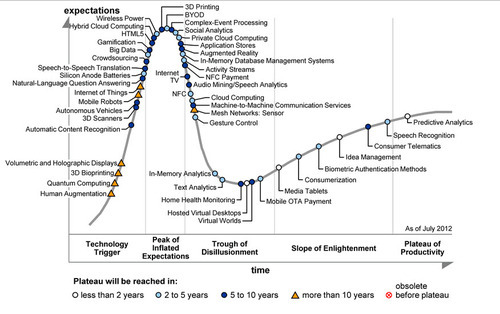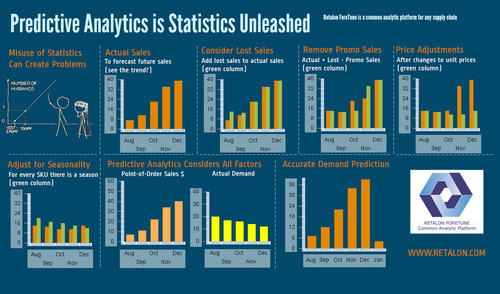In predictive analytics, first understand the questions then be willing to act on the answers
There are three key questions executives need to ask when considering predictive analysis according to KINSHIP digital general managerWalter Adamson:
- What question do we want answered?
- What can we do when we have that answer?
- How do we influence any actions we desire when we know that we can act?
“These questions are fundamental, but are often overlooked or rushed in the excitement the wonderful promise of predictive analysis,” he says.
“Overlooking them will lead to failure, or at best to inefficient and ineffective investments in predictive analysis and its consequences.”
So pervasive has the term big data become as it has emerged as the tech sector’s panacea du jour that many people have lost site of the fact that is it not a monolithic discipline but rather a family of strategies, tools, products and approaches.
Take predictive analytics, one of the more frequently misunderstood sub categories of big data and also one of the more mature disciplines. A recent global IBM study into analytics found that 67 per cent of companies with big data projects were actively engaged in predictive analysts, making it one of the top five data capabilities.
While big data generally, and technologies like social analytics specifically are at the very peak of Gartner’s famous technology hype cycle, predictive analytics has already passed through the trough of disillusionment, transcended the slope of enlightenment and arrived at Gartner’s plateau of productivity.

(Gartner technology adoption hype cycle. Source: Gartner)
Adamson told Which-50, “When companies talk about predictive analysis they usually mean the ability to classify a group of customers or potential customers or just people or things with respect to a specific outcome.”
For example;
- The customers most likely to churn at the end of a contract;
- Those women most likely to conceive through an IVF program;
- Those sign-ups most likely to shift from being a freemium user to a paid user;
- The correct answer to a Jeopardy question.
“Many companies use the term “predictive analysis loosely,” according to Adamson. “They are actually talking about insights from the application of better data analysis and visualization tools – this is actually descriptive analysis he says.
“For a Marketing group, knowing how receptive people may be to a certain type of message is certainly a key issue. However predictive analysis does not help with that issue and many a false turn has been made by companies in that regard. In fact the messages sent to certain identified groups can often have the opposite effect to that intended.”
“Clearly, the true application of predictive analysis to predict what is likely to happen is extremely valuable. The telcos have been using these techniques for a long time in relation to end-of-contract churn, for example.
Predictive analytics has the power to predict and influence the future and the critical point, according to author Eric Siegel it does this for everyone one person at a time to “determine whether you are going to click, lie, buy or die.”
“The fact that the predictions on are this level – that’s the defining characteristic of this technology it enables organisations to improve their operations – to operate more effectively.”
(Video: Eric Siegel, author of “Predictive Analytics: The Power to Predict Who Will Click, Buy, Lie, or Die. Source YouTube)
Consumers will hand over huge amounts of personal data with the aim of minimizing irrelevant communications and for those customers so there is plenty of value in predictive analytics says Constellation Research VP Gavin Heaton.
According to Heaton, “Some customers like being presented with choices that are aligned with their interests. These people will actively cultivate brands and engage with their marketing in very targeted ways.”
“But even if your customers don’t want to share information and data with you, there is much that today’s marketer can do to understand their customers.”
Spending the time examining analytics data, spotting trends and patterns, testing hypothesis, behaviors and personas can allows companies to create powerful – and largely accurate – maps of their customer’s journey and experience, according to Heaton
“In this, rather than looking for data, we must look for insight. Unfortunately we seem to confuse the two. “
The challenge of predictive analytics is not whether it can be relevant, he says.”I have no doubt that eventually there will be enough data and enough processing power to make it work.”
Instead the challenge is to avoid a “creep factor” that destroys the brand experience altogether. “We are already seeing people starting to question sites like LinkedIn over the “people you might know” algorithm. As we have learned from social media, there’s a fine line between being helpful and stalking.”
Don’t be creepy
Adamson tackles this point.”There is a notion or perhaps feeling that predictive analytics is a big-brotherish type of technology, analyzing data captured behind backs and predicting behavior – Mission Impossible style.”
But he says, this is not the case. For one thing it’s simply not that good.
“NSA PRISM has thousands of experts doing this but they didn’t predict the Boston bombers.”

(Image: Walter Adamson, Source Twitter)
Adamson says the technology is not aimed at exploiting customers but rather at improving service, and providing better value, and or at the very least improving the performance of the firm.
“Having a highly relevant advertisement appear when you are looking to buy something is helpful; knowing that you have a better chance of conceiving by IVF is encouraging and helpful; knowing that you need to do maintenance within the next four running hours on a particular engine part is extremely helpful; and knowing that if you have a certain combination of social benefits, demographics and social media behavior that you may be entitled to another benefit is helpful.”
Adamson says he understands why some people might question some of the outcomes.
He notes that banks for instance are keen to identify and bundle their likely defaulters for example potential home mortgage defaulters. “They may want to monetize them or securitize them or sell them off for the right price – and that’s been an early use of predictive analytics.
“But in fact the customers are not disadvantaged here.” Instead, he says, “The disadvantaged party is most often a buyer (of the securities) who does not have the same predictive analytics capabilities. One company is taking advantage of another company. There is a disadvantaged group, but it is not the mortgagees. Whether they are better or worse off would depend on their original contracts and the terms of the sale.”
Businesses, says Adamson, cannot afford to exploit customers – in any sense of the word.
“Predictive analytics offers new opportunities to deliver value to customers, and value to the firm. I think it’s that simple. What’s hard is to get the overall thinking right and the framework right, and to not be blinded by the technology and the over-promises.”
via Which-50.
In predictive analytics, first understand the questions then be willing to act on the answers

